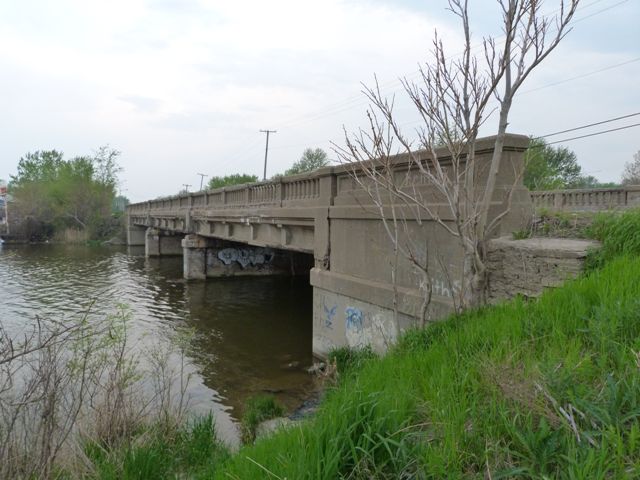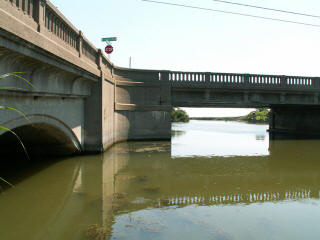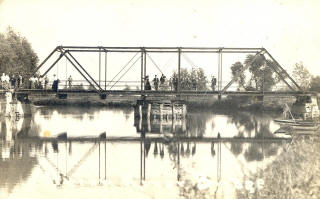We Recommend:
Bach Steel - Experts at historic truss bridge restoration.
BridgeHunter.com Phase 1 is released to the public! - Visit Now
Jefferson Avenue Bridge
Jefferson Avenue - Harbin Drive Bridge

Primary Photographer(s): Nathan Holth and Luke Gordon
Bridge Documented: August 1, 2005 and May 13, 2011
Rural: Wayne County, Michigan and Monroe County, Michigan: United States
1931 By Builder/Contractor: W. J. Anschutz of Saginaw, Michigan and Engineer/Design: Michigan State Highway Department
Not Available or Not Applicable
54.8 Feet (16.7 Meters)
165.0 Feet (50.3 Meters)
36 Feet (10.97 Meters)
1 Main Span(s)
82200185000B010

View Information About HSR Ratings
Bridge Documentation
View Archived National Bridge Inventory Report - Has Additional Details and Evaluation

The Jefferson Avenue Bridge and the Harbin Drive Bridge are two separate structures with different construction dates, but they have been made to have the appearance of a single bridge such as the Hill-To-Hill Bridge. As such, they contribute to each other, and it is impossible to discuss one of these bridges without including the other. This narrative and the accompanying photo gallery discusses and covers both bridges at once. However, the Key Facts, Technical Facts, and NBI Sheet on this page refer to the Jefferson Avenue Bridge. Switch pages here to view data for the Harbin Drive Bridge.
These bridges are interesting because they share a continuous railing, as shown on the above photo. The Harbin Drive Bridge, which is a concrete arch bridge, is actually older than the Jefferson Avenue Bridge, and all the railing on it. The railing, and some of the angling of the bridge was changed to match the Jefferson Avenue Bridge, which was built in 1930. MDOT mentions that the bridges are significant because they are the product of an Assessment District. The plaque on the bridge lists this as well. This is because Huron River forms the county line between Monroe and Wayne County.
 The Harbin Drive Bridge looks quite attractive as an arch
bridge, with its 1930 guardrails above. It has a bit of a slope to get up to
Jefferson Avenue Bridge. This is probably one of the changes made to Harbin
Avenue when Jefferson Avenue Bridge was built. As you approach the bridge from a
distance, the dirt approaches for the bridge are clearly visible. The Jefferson Avenue Bridge was
given some additional height when built to provide clearance for boats. Indeed,
the 1930 bridge replaced a through truss swing bridge (hand-turned), so at the
time the river was used for navigation. A photo of the swing bridge existing
prior to this bridge is available to the right. Note the endposts of a pony truss
approach span are visible to the left in the photo, and a plaque is mounted on
top of the portal bracing. However not enough detail of truss or plaque is
visible to take a guess on the builder.
The Harbin Drive Bridge looks quite attractive as an arch
bridge, with its 1930 guardrails above. It has a bit of a slope to get up to
Jefferson Avenue Bridge. This is probably one of the changes made to Harbin
Avenue when Jefferson Avenue Bridge was built. As you approach the bridge from a
distance, the dirt approaches for the bridge are clearly visible. The Jefferson Avenue Bridge was
given some additional height when built to provide clearance for boats. Indeed,
the 1930 bridge replaced a through truss swing bridge (hand-turned), so at the
time the river was used for navigation. A photo of the swing bridge existing
prior to this bridge is available to the right. Note the endposts of a pony truss
approach span are visible to the left in the photo, and a plaque is mounted on
top of the portal bracing. However not enough detail of truss or plaque is
visible to take a guess on the builder.
The Jefferson Avenue Bridge is a long example of the standard plan 1930s beam bridge style, with three spans. There are no weight limits present on either of the bridges, and the Jefferson Avenue Bridge carries a fair amount of traffic, including a good number of heavy trucks. This has deteriorated the deck a bit, and the trucks, which never seem to slow down, make an awful noise as they speed across the bridge. There should be a reduced speed limit to slow traffic down for safety, as well as for the wellbeing of the bridge.
Information and Findings From Michigan Historic Bridge InventoryNarrative Description The Jefferson Avenue and Harbin Drive Bridges are eligible for the
National Register as an example of an assessment district project. In
addition, the Jefferson Avenue Bridge is eligible as an early long-span
stringer bridge. |
![]()
Photo Galleries and Videos: Jefferson Avenue Bridge
Bridge Photo-Documentation
Original / Full Size PhotosA collection of overview and detail photos. This gallery offers photos in the highest available resolution and file size in a touch-friendly popup viewer.
Alternatively, Browse Without Using Viewer
![]()
Bridge Photo-Documentation
Mobile Optimized PhotosA collection of overview and detail photos. This gallery features data-friendly, fast-loading photos in a touch-friendly popup viewer.
Alternatively, Browse Without Using Viewer
![]()
Jefferson Ave. Southbound Crossing
Full Motion VideoStreaming video of the bridge. Also includes a higher quality downloadable video for greater clarity or offline viewing.
![]()
Maps and Links: Jefferson Avenue Bridge
Coordinates (Latitude, Longitude):
Search For Additional Bridge Listings:
Bridgehunter.com: View listed bridges within 0.5 miles (0.8 kilometers) of this bridge.
Bridgehunter.com: View listed bridges within 10 miles (16 kilometers) of this bridge.
Additional Maps:
Google Streetview (If Available)
GeoHack (Additional Links and Coordinates)
Apple Maps (Via DuckDuckGo Search)
Apple Maps (Apple devices only)
Android: Open Location In Your Map or GPS App
Flickr Gallery (Find Nearby Photos)
Wikimedia Commons (Find Nearby Photos)
Directions Via Sygic For Android
Directions Via Sygic For iOS and Android Dolphin Browser
USGS National Map (United States Only)
Historical USGS Topo Maps (United States Only)
Historic Aerials (United States Only)
CalTopo Maps (United States Only)


